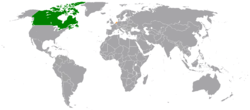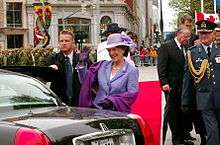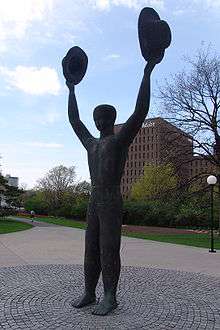Canada–Netherlands relations
 |
|
Canada |
Netherlands |
|---|---|
Canada and the Netherlands have a special relationship resulting from actions during World War II when Canadian forces led the liberation of the Netherlands and hosted the Dutch Royal Family in exile. The special relationship is still visible as of 2015, with the Canadian government describing the Netherlands as "one of Canada's most significant trade, investment and innovation partners."[1] In part, the Canadian Tulip Festival still commemorates this relationship.
History
World War II to present
Following German Occupation of the Netherlands, the Dutch royal family took refuge in Canada. Princess Margriet was born in exile while her family lived in Ottawa. The maternity ward of Ottawa Civic Hospital in which Princess Margriet was born was temporarily declared to be extraterritorial by the Canadian government, thereby allowing her citizenship to be solely influenced by her mother's Dutch citizenship. To commemorate the birth, the Canadian Parliament flew the Dutch flag over Peace Tower. This is the only time a foreign flag has flown over the Canadian Parliament Building.[2]

During 1945, the First Canadian Army was responsible for liberating the Netherlands, which they did through battles such as the Battle of the Scheldt and the Liberation of Arnhem. The liberation of the Randstad, one of the most densely populated areas in the world, is especially notable because the civilian population there was still suffering from the horrific effects of the Hongerwinter ('Hungerwinter'). It was cut off from food that was available in the rest of the Netherlands. German forces in the Netherlands would finally surrender in Wageningen, on 5 May 1945, but not before some 18,000 Dutch civilians died as a result of starvation and malnutrition (desperate coordinated air drops of food had already been staged by the Royal Canadian Air Force over German-occupied Dutch territory in Operation Manna. Civilians wrote "Thank You Canadians!" on their rooftops in response). Immediately following the surrender, Canadian units were able to move into the Randstad and rapidly distribute desperately needed food supplies, causing many to see the Canadians not only as liberators but as saviours.
In appreciation, the Dutch people sent tens of thousands of tulips (the Dutch national flower) to Ottawa. In the following year, the royal family contributed thousands as well, and a further ten thousand yearly since. The donations became an annual tradition, culminating in the Canadian Tulip Festival.
State visits

In May 1967, Queen Juliana of the Netherlands visited Canada.[3] From 9–17 May 1988 Queen Beatrix of the Netherlands and Prince Claus of the Netherlands visited Canada.[4] King Willem-Alexander and Queen Máxima paid a widely publicized state visit to Canada from 27–29 May 2015, receiving an extremely warm welcome, particularly in Ontario.
International Cooperation
Canada and the Netherlands have worked very closely together on many foreign issues. They are both members of the United Nations (and its Specialized Agencies), the World Trade Organization, Interpol, they are both founding members of the North Atlantic Treaty Organization (NATO), the Euro-Atlantic Partnership Council (EAPC), the Organization for Security and Cooperation in Europe (OSCE), and the Stability Pact for South Eastern Europe. Canada and the Netherlands also work together on such issues as the prohibition and elimination of anti-personnel mines, the control of the proliferation of small arms and light weapons, eradicating the worst forms of child labour, the provision of rapid reaction peacekeeping forces to the United Nations (SHIRBRIG) and regional security issues such as Bosnia (SFOR) and Ethiopia and Eritrea (UNMEE).
Recent Military Cooperation
The Dutch and Canadian armed forces regularly fought together in the War in Afghanistan until the withdrawal of the Netherlands in 2010.
Afghanistan
Canada's role in the invasion of Afghanistan was to help train the Afghan National Army and police, facilitate reconstruction, in addition to provide security. However, in 2006, with the situation in Kandahar Province turned increasingly violent, the Canadian Forces participated in several operations and battles. The Royal Canadian Air Force have a major presence in Afghanistan, including three CC-130 Hercules cargo planes, two CP-140 surveillance planes,[5] six CH-147 Chinook transport helicopters, six Mil Mi-8 leased for one year from Skylink Aviation, eight CH-146 Griffon utility helicopters and three CU-170 Unmanned Aerial Vehicle (UAV). The Canadian Army have increased its presence with main battle tanks, some ten Leopard C2 and twenty Leopard 2A6M CAN, approximately one hundred LAV III armoured vehicles and currently use six 155 mm M777 howitzers in Afghanistan.

As part of Operation Enduring Freedom, the Netherlands also deployed aircraft as part of the European Participating Air Force (EPAF) in support of ground operations in Afghanistan as well as Dutch naval frigates to police the waters of the Middle East/Indian Ocean. The Netherlands deployed further troops and helicopters to Afghanistan in 2006 as part of a new ISAF security operation in the south of the country.[6] Dutch ground and air forces totalled almost 2,000 personnel during 2006, taking part in combat operations alongside British and Canadian forces as part of NATO's ISAF force in the south. The Netherlands announced in December 2007 that it will begin withdrawing its Dutch Armed Forces troops from Afghanistan, mainly in the province of Uruzgan, in July 2010. "I do not have assurances that other countries will be ready to replace Netherlands troops, but I am certain that Dutch troops will leave in 2010", Foreign Minister Maxime Verhagen said. "I indicated that in writing ... to the NATO secretary general, who has confirmed it."[7] Last minute negotiations in February 2010 after a further NATO request did not change this stance,[8] and there was a handover of command to the United States and Australia on 1 August 2010, formally ending the Dutch military mission, though a redeployment task force would remain for the rest of the year to complete the return of vehicles and other equipment to the Netherlands.[9]
Military sales
In 2007, the Netherlands sold 100 Leopard tanks to Canada. This include 20 Leopard 2-A6s and 80 Leopard 2-A4s. The agreement was announced during Dutch Defence Minister Eimert van Middelkoop's visit to Canada. As part of the agreement, the Dutch army intended to provide training for Canadian instructors.[10] The Dutch Army also uses the Colt Canada C7 Rifle as their service rifle.
Military Treaties
Canada and the Netherlands have signed two separate treaties to govern and allow for the deployment of soldiers for training and mutual defense, in each other's territory.
Migration

According to the Canada 2006 Census, there are 1,035,965 Canadians of Dutch descent, including those of full or partial ancestry. Over 400,000 people of Dutch origin are permanent residents of Canada and in 1996 (the last census figures available) 124,545 residents of Canada were listed as being born in the Netherlands: 0.4 percent of the Canadian population. The Dutch Language is the 7th most spoken language in Canada.[11] It is also the third most spoken language in Prince Edward Island[12]
Of all immigrant groups in Canada, those who are Dutch-speaking have shown a preference for farming that exceeds all other major groups. The capital and expertise they bring have made a substantial contribution to agriculture in Canada. Most Dutch immigrants settle in Ontario. Ontario has the lion's share of all Dutch immigrant farmers in Canada, with 58%. Alberta and British Columbia have similar proportions: 18% and 14% respectively. The Dutch represent a significant proportion of immigrants in the Atlantic provinces.[13]
The Dutch are world leaders in greenhouse technologies and many have brought their expertise to Canada. Thirty percent of all immigrant-run green-house operations have Dutch immigrants at the helm in Canada. Just under one-quarter of all immigrant nursery operators are Dutch.[13]
According to the Canadian Embassy in The Hague, between 4500 and 5000 Canadians live in the Netherlands.[14]
In London, Ontario the Dutch Canadian Society runs the Dutch Canadian Club one of the most popular clubs in that city.[15]
Trade
In 2006, the Netherlands were the 8th ranked destination for Canadian exports (0.7%).[16] Canada and the Netherlands enjoy a mature relationship based on political, investment, trade, and historical ties.[17] To foster business and commercial relations between the Netherlands and Canada, the Dutch business community set up the Netherlands-Canadian Chamber of Commerce.[18]
Visa Exemptions
Both countries exempt each other's citizens from obtaining a visa to enter. Visa-free travel is fully available to Canadian citizens in the Netherlands for a 3-month period occurring in a half year.[19][20] Dutch citizens in Canada can travel visa-free for up to 6 months from date of entry.[21]
Youth Exchange
Because of the special relationship they share, Canada and the Netherlands have adopted liberal policies exclusive to one another and offer special working visas to youth from each country.[22][23] However, these special visa policies have conditions: Dutch Youth must have a job offer before the visa is granted and Canadian Youth must agree to limits of how long they can remain in the Netherlands. Citizens of the Netherlands and Canada between the ages of 18 and 25 are eligible and there are no restrictions for applicants status (non-students).[24][25] The visa allows for travel time to pass the usual limit. (see Working holiday visa)
See also
References
- ↑
- ↑ "The Parliament Buildings and Grounds". House of Commons Procedure and Practice. Parliament of Canada. 2009. Retrieved 16 September 2011.
- ↑ "The Calgary Herald - Google News Archive Search". google.com.
- ↑ Staatsbezoeken van Hare Majesteit de Koningin (in Dutch) Retrieved 19 October 2012
- ↑ "405 Sqn Deploys to South West Asia ... | Articles | News & Events – News Room | 14 Wing Greenwood | Air Force | DND/CF". Airforce.forces.gc.ca. 5 June 2009. Archived from the original on 11 June 2011. Retrieved 23 June 2010.
- ↑ "More Dutch troops for Afghanistan BBC Friday, 3 February 2006". BBC News. 3 February 2006. Retrieved 19 April 2012.
- ↑ "Netherlands confirms 2010 Afghanistan pullout". Australia: ABC. 19 December 2007. Retrieved 5 July 2010.
- ↑ Marquand, Robert (22 February 2010). "Dutch government collapse: Will other European troops now leave Afghanistan?". Christian Science Monitor. Retrieved 22 February 2010.
- ↑ "Dutch troops end Afghanistan deployment". BBC. 1 August 2010. Retrieved 1 August 2010.
- ↑ "Netherlands Sells Leopard Tanks To Canada". Nisnews.nl. Retrieved 19 April 2012.
- ↑ Census Canada 1995 report
- ↑ "See the PEI section". Canada: CBC. Retrieved 19 April 2012.
- 1 2
- ↑ "Canada-Netherlands Relations". Canadainternational.gc.ca. 1 March 2012. Retrieved 19 April 2012.
- ↑ "www.dutchcanadiansociety.com". dutchcanadiansociety.com. Retrieved 19 April 2012.
- ↑ Canada Is A Trading Nation – Canada's Major Trading Partners Archived June 3, 2008, at the Wayback Machine.
- ↑ "Canada-Netherlands Relations". Canadainternational.gc.ca. 1 March 2012. Retrieved 19 April 2012.
- ↑ http://www.netherlandscanada.nl/
- ↑ http://eur-lex.europa.eu/LexUriServ/site/en/consleg/2001/R/02001R0539-20050624-en.pdf
- ↑ http://eur-lex.europa.eu/LexUriServ/site/en/oj/2007/l_029/l_02920070203en00100013.pdf
- ↑ "Countries/Territories requiring visas". Cic.gc.ca. 11 July 2011. Retrieved 19 April 2012.
- ↑ "International Student Exchange – Holland". Youthedservices.ca. Retrieved 19 April 2012.
- ↑ Archived November 2, 2011, at the Wayback Machine.
- ↑ "Canadian Immigration and Visas | Canada Working Holiday Program". Workpermit.com. Retrieved 19 April 2012.
- ↑ (PDF) https://web.archive.org/web/20101011053207/http://www.ind.nl/en/Images/4012_tcm6-595.pdf. Archived from the original (PDF) on October 11, 2010. Retrieved November 17, 2011. Missing or empty
|title=(help)
External links
- CANADAEuropa/The Netherlands
- Netherlands-Canadian Chamber of Commerce
- Black-and-white image of Dutch national flag atop Peace Tower
